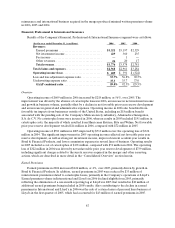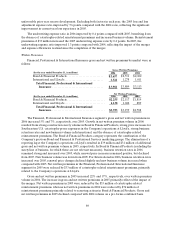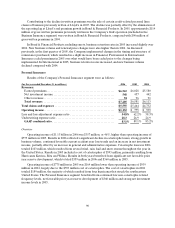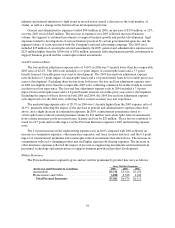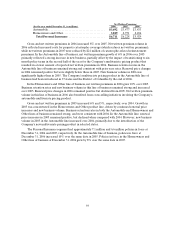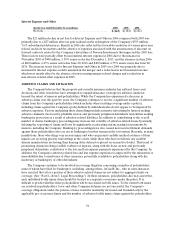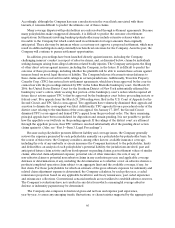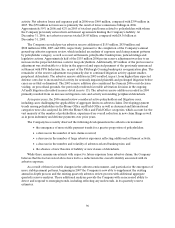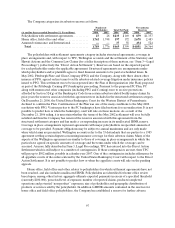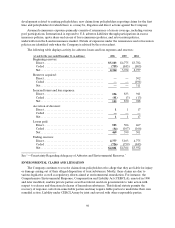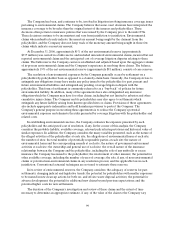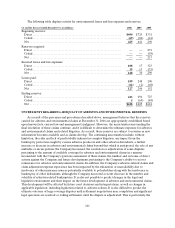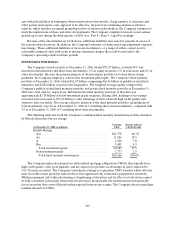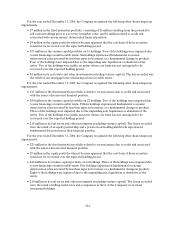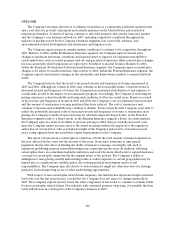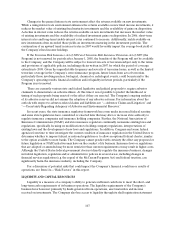Travelers 2006 Annual Report Download - page 109
Download and view the complete annual report
Please find page 109 of the 2006 Travelers annual report below. You can navigate through the pages in the report by either clicking on the pages listed below, or by using the keyword search tool below to find specific information within the annual report.
97
The Company categorizes its asbestos reserves as follows:
Number of
Policyholders Total Net Paid
Net Asbestos
Reserves
(at and for the year ended December 31, $ in millions) 2006 2005 2006 2005 2006 2005
Policyholderswith settlement agreements........... 27 28 $ 2 35 $ 1 69 $ 879 $1,357
Home office,field office and other ................. 1,762 1,748 197 172 2,678 2,483
Assumed reinsurance and International............ —
—
37 58
494 524
Total ......................................... 1,789 1,776 $ 4 69 $ 3 99 $4,051 $4,364
The policyholders with settlement agreements category includes structured agreements, coverage in
place arrangements and, with respect to TPC, Wellington accounts and the settlement of the Statutory and
Hawaii Actions and the Common Law Claims (for a fuller description of these matters, see “Item 3—Legal
Proceedings”) (collectively the “Direct Action Settlement”). Reserves are based on the expected payout
for each policyholder under the applicable agreement.Structured agreements are arrangements under
which policyholders and/or plaintiffs agree to fixed financial amounts to be paid at scheduled times. In
May 2002, Pittsburgh Plate and Glass Company (PPG) and the Company, along with three dozen other
insurers of PPG, agreed on key terms to settle asbestos-related coverage litigation under insurancepolicies
issued to PPG. This settlement was to be incorporated into the Plan of Reorganization (the Plan) proposed
as part of the Pittsburgh Corning (PC) bankruptcy proceeding. Pursuant to the proposed PC Plan, PC
along with enumerated other companies (including PPG and Corning) were to receive protections
afforded by Section 524(g) of the Bankruptcy Code from certain asbestos-related bodily injury claims. In
prior years the reserves associated with this agreement were included in the structured settlement category.
On December 21, 2006, the United States Bankruptcy Court for the Western District of Pennsylvania
declined to confirm the Plan. Confirmation of the Plan was one of the many conditions to the May 2002
resolution with PPG. Various parties to the PC bankruptcy have filed motions for reconsideration. It is not
possible to predict how or when the bankruptcy court will rule on these motions. As a result of the
December 21, 2006 ruling, it is uncertain whether the terms of the May 2002 settlement will ever be fully
satisfied and thus the Company has removed the reserves associated with this agreement from the
structured settlement category and has made a corresponding increase in its unallocated IBNR reserve.
Coverage inplace arrangements represent agreements with major policyholders on specified amounts of
coverage to be provided. Payment obligations may be subject to annual maximums and are only made
when valid claims are presented. Wellington accounts refer to the 35 defendants that are parties to a 1985
agreement settling certaindisputes concerning insurance coverage fortheir asbestos claims. Manyof the
aspects of the Wellington agreement are similar to those of coverage inplace arrangements in which the
parties have agreed on specific amounts of coverage andthe terms under which the coverage can be
accessed. Asmore fullydescribed in Item 3, Legal Proceedings,TPC has entered into the Direct Action
Settlement which is still subject to a number of contingencies. If those contingencies are met, then TPC
will pay up to $502 million, possibly in calendar year 2007. One of the contingencies includes affirmance by
all appellate courts of the orders entered by the United States Bankruptcy Court with respect to the Direct
Action Settlement. It is not possible to predict how or when the appellate courts will rule on the pending
appeals.
Home office, field office and other relates to policyholders for which settlement agreements have not
been reached, and also includes unallocated IBNR. Policyholders are identified for home office review
based upon, among other factors: aggregate ultimate expected payments in excess of a specified threshold
(currently $100,000), perceived level of exposure, number of reported claims, products/completed
operations andpotential “non-product” exposures, size of policyholder andgeographic distribution of
products or services sold by the policyholder. In addition to IBNR amounts contained in the reserves for
home office and field office policyholders, the Company has established a reserve for further adverse


